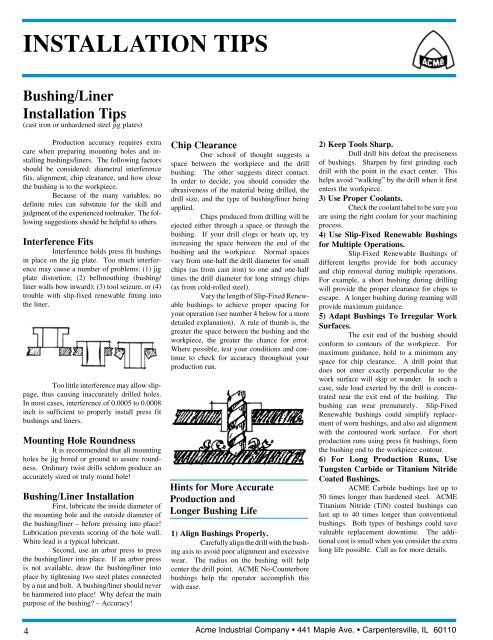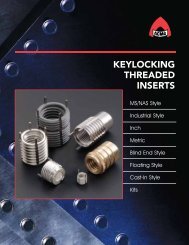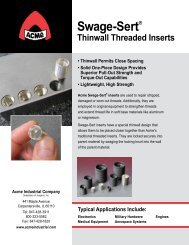ACME Precision Bushings - Acme Industrial
ACME Precision Bushings - Acme Industrial
ACME Precision Bushings - Acme Industrial
Create successful ePaper yourself
Turn your PDF publications into a flip-book with our unique Google optimized e-Paper software.
INSTALLATION TIPS<br />
Bushing/Liner<br />
In stal la tion Tips<br />
(cast iron or unhardened steel jig plates)<br />
Production accuracy requires extra<br />
care when preparing mounting holes and in -<br />
stall ing bushings/liners. The following fac tors<br />
should be considered: diametral interference<br />
fits, alignment, chip clearance, and how close<br />
the bushing is to the workpiece.<br />
Because of the many variables, no<br />
definite rules can substitute for the skill and<br />
judgment of the experienced toolmaker. The following<br />
suggestions should be helpful to oth ers.<br />
Interference Fits<br />
Interference holds press fit bushings<br />
in place on the jig plate. Too much interference<br />
may cause a number of problems: (1) jig<br />
plate distortion; (2) bellmouthing (bushing/<br />
liner walls bow inward); (3) tool seizure, or (4)<br />
trouble with slip-fixed renewable fitting into<br />
the liner.<br />
Too little interference may allow slippage,<br />
thus causing inaccurately drilled holes.<br />
In most cases, interference of 0.0005 to 0.0008<br />
inch is sufficient to properly install press fit<br />
bushings and liners.<br />
mounting Hole Roundness<br />
It is recommended that all mounting<br />
holes be jig bored or ground to assure roundness.<br />
Ordinary twist drills seldom produce an<br />
ac cu rate ly sized or truly round hole!<br />
Bushing/Liner Installation<br />
First, lubricate the inside diameter of<br />
the mounting hole and the outside diameter of<br />
the bushing/liner – before pressing into place!<br />
Lubrication prevents scoring of the hole wall.<br />
White lead is a typical lubricant.<br />
Second, use an arbor press to press<br />
the bushing/liner into place. If an arbor press<br />
is not available, draw the bushing/liner into<br />
place by tightening two steel plates connected<br />
by a nut and bolt. A bushing/liner should never<br />
be ham mered into place! Why defeat the main<br />
purpose of the bushing? – Accuracy!<br />
4<br />
Chip Clearance<br />
One school of thought suggests a<br />
space between the workpiece and the drill<br />
bushing. The other suggests direct contact.<br />
In order to decide, you should consider the<br />
abrasiveness of the material being drilled, the<br />
drill size, and the type of bushing/liner being<br />
applied.<br />
Chips produced from drilling will be<br />
ejected either through a space or through the<br />
bushing. If your drill clogs or heats up, try<br />
increasing the space between the end of the<br />
bushing and the workpiece. Normal spaces<br />
vary from one-half the drill diameter for small<br />
chips (as from cast iron) to one and one-half<br />
times the drill diameter for long stringy chips<br />
(as from cold-rolled steel).<br />
Vary the length of Slip-Fixed Re newable<br />
bushings to achieve proper spacing for<br />
your operation (see number 4 below for a more<br />
detailed explanation). A rule of thumb is, the<br />
greater the space between the bushing and the<br />
workpiece, the greater the chance for error.<br />
Where possible, test your conditions and contin<br />
ue to check for accuracy throughout your<br />
pro duc tion run.<br />
Hints for more Accurate<br />
Pro duc tion and<br />
Longer Bushing Life<br />
1) Align <strong>Bushings</strong> Properly.<br />
Carefully align the drill with the bushing<br />
axis to avoid poor alignment and excessive<br />
wear. The radius on the bushing will help<br />
center the drill point. <strong>ACME</strong> No-Counterbore<br />
bush ings help the operator accomplish this<br />
with ease.<br />
2) keep Tools Sharp.<br />
Dull drill bits defeat the preciseness<br />
of bushings. Sharpen by first grinding each<br />
drill with the point in the exact center. This<br />
helps avoid “walking” by the drill when it first<br />
enters the workpiece.<br />
3) Use Proper Coolants.<br />
Check the coolant label to be sure you<br />
are using the right coolant for your machining<br />
process.<br />
4) Use Slip-Fixed Renewable <strong>Bushings</strong><br />
for multiple Operations.<br />
Slip-Fixed Renewable <strong>Bushings</strong> of<br />
different lengths provide for both accuracy<br />
and chip removal during multiple operations.<br />
For example, a short bushing during drilling<br />
will provide the proper clearance for chips to<br />
escape. A longer bushing during reaming will<br />
provide maximum guidance.<br />
5) Adapt <strong>Bushings</strong> To Irregular work<br />
Surfaces.<br />
The exit end of the bushing should<br />
conform to contours of the workpiece. For<br />
maximum guidance, hold to a minimum any<br />
space for chip clearance. A drill point that<br />
does not enter exactly perpendicular to the<br />
work sur face will skip or wander. In such a<br />
case, side load exerted by the drill is concentrated<br />
near the exit end of the bushing. The<br />
bushing can wear prematurely. Slip-Fixed<br />
Renewable bushings could simplify replacement<br />
of worn bushings, and also aid alignment<br />
with the contoured work surface. For short<br />
production runs using press fit bushings, form<br />
the bushing end to the workpiece contour.<br />
6) For Long Production Runs, Use<br />
Tung sten Carbide or Titanium Nitride<br />
Coated <strong>Bushings</strong>.<br />
<strong>ACME</strong> Carbide bushings last up to<br />
50 times longer than hardened steel. <strong>ACME</strong><br />
Ti ta ni um Nitride (TiN) coated bushings can<br />
last up to 40 times longer than conventional<br />
bush ings. Both types of bushings could save<br />
valuable replacement downtime. The additional<br />
cost is small when you consider the extra<br />
long life possible. Call us for more details.<br />
<strong>Acme</strong> <strong>Industrial</strong> Company • 441 Maple Ave. • Car pen tersville, IL 60110




